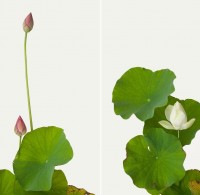TAKASHI TOMO OKA
hasu (lotus)
source: designboom
takashi tomo-oka’s photographs can be described as contemporary nihonga-style pictures. they represent a new form of painting that is carried out not with ink and brushes, but using a digital camera then printing the resulting image on handmade paper. ‘I wish to express the beauty of ‘kaboku’, which is to say, flowers and trees, using photographic techniques to create an image resembling a painting.
I want to be able to feel the unadorned beauty of the plants, using a composition consisting solely of the plant and empty space, making the picture as simple as possible.’ says takashi tomo-oka. ‘there is a big difference between photographs and paintings. in painting the artist looks at the subject, considers it, then passes it through the ‘filter’ of his or her physical body to depict it; photography is much more direct.
photography cannot exist without a concrete subject (in my case flowers). there has to be something material in order for the camera to cut out a moment of its existence. when photographing plants, their natural power and aesthetics are expressed directly without passing through the filter that is me.
I photograph plants that are on the verge of decay because they are beautiful. it is my ambition to capture the expressions unique to each plant.
if you can feel the power of the plant, then my ability and individuality becomes almost unnecessary’.
.
.
.
.
.
.
source: elledecor
You can learn a lot about Takashi Tomo-oka from looking at his photographs. His minimalist images of fragile-looking flower blossoms, plants, and branches recall the Japanese Edo-period paintings he studied in art school. His pictures are often printed on handmade washi paper and mounted on silk to resemble the temple scrolls Tomo-oka liked to examine while growing up in Kyoto. The washi paper, which has a softening effect upon these austere photographs shot with a digital camera, is similar to the kind he used as a boy learning the art of calligraphy. “What I saw as a child has a big influence,” Tomo-oka explains. “The basis of my work is everything I have experienced in the past.”
The Tokyo-based photographer may sport earrings and an oversize, of-the-moment digital watch, but his images are imbued with Japanese traditions, especially his country’s centuries-old visual love affair with the natural world—even if all you notice at first is a slender stalk of bamboo ginger, a wispy rice leaf, or the blood-red pop of a dahlia in full bloom.
Flowers, in fact, are his thing. In high school Tomo-oka worked part time for a florist; then, while studying painting at Kyoto Seika University, he went on to assist a landscape gardener in charge of caring for temple grounds. An elective course sparked an interest in photography, leading him to launch a career that brings together his twin passions. The artist is so enamored of the botanical world that when he travels, he says, he would rather visit a garden than a gallery; his favorites are those in Japan with their spare landscapes of sand and stone.
While Tomo-oka has shot several thousand plants in the past two decades, he’s produced only about 100 finished works. Some two dozen of his graceful prints—of wisteria and lotus, Japanese apricot blossom and Chinese peony—were mounted on hanging scrolls and exhibited last winter at Ippodo Gallery in New York, his first solo show in the U.S. And one of Japan’s oldest obi makers, Kondaya Genbei, was so enchanted with Tomo-oka’s bold compositions that the 274-year-old Kyoto firm is using a pair of his images, Dahlia (2010) and White Spider Lily (2009), for newly designed kimono sashes.
The Japanese principle of wabi-sabi—an aesthetic ideal based on finding beauty in imperfection and impermanence—is the guiding spirit of his work. What makes plants so compelling, Tomo-oka says, “is not just their beauty but also their dark side—dying leaves or ones eaten by bugs, rotting berries, even poisonous weeds that people usually avoid because they give off a bad smell.”
For each photograph, Tomo-oka begins by studying the shape of a plant as it grows. (Talk about patience!) He’ll watch how a stem curves, how a bloom opens, so when he’s ready to take a picture he can, he says, “capture it in its most natural essence.” Currently he has 90 or so specimens growing in pots on the terraces of his studio in the trendy Harajuku district and at his home on the outskirts of the city. (He also scours Tokyo’s flower market and florists for blooms.) That’s because, after they’ve been shot, he can’t bear to toss out the plants. “The next time I move, I’ll definitely need a bigger terrace,” he jokes.
Tomo-oka’s next step is to make a sketch, creating a diagram of how he wants the plant to look as a photograph, accounting for the ample white space that gives his images their modern edge. Then he snips and shoots. “Once I cut a flower from a stem, I have only a very short time to get the right image,” Tomo-oka explains. “A morning glory wilts fast. Five minutes is probably too long.”
For dandelions, on the other hand, he has to take it slowly. Tomo-oka picks them in the wild, repots them on his terrace, then keeps them out of the wind as they flourish. When the florets have gone to seed, transforming into fragile, finely haired spheres, he gently carries them inside to his studio and tries not to sneeze.
.
.
.
.
.
.
source: kamigata-ginkajp
花々が、美しい季節の移ろいを感じさせてくれる 日本。
鞆岡隆史氏は、そんな花の一瞬を デジタルカメラで刻み取ります。
その写真を和紙に転写した作品は、現代の日本画であり、今日の琳派と
いえます。
昨年1月には 上方銀花姉妹店の一穂堂NYで発表、サンディエゴ写真
美術館館長の目に留まり 同館に作品が収蔵。また、インテリア誌エル・
デコ(USA)や 建築誌AD(ドイツ)に掲載され、初の海外出展は高い評価
を得ました。
掛軸や屏風、額 等、鞆岡氏の花木のエッセンスが 上方銀花で花開き
ます。関西で初めてのお目見え、他にはない美しい世界を ぜひご高覧
くださいませ。
.
.
.
.
.
.
source: kamigata-ginkacocolog-nifty
鞆岡隆史氏の作品は、デジタルカメラで花々の美しい一瞬を
刻み取ったものです。
それは、鞆岡先生だけの幽玄の世界です。
自己の身体や心に内包する絶対美学、黄金比が、琳派に
通じる空間の美を画面に構成し、細長い花の写真を薄い
和紙に転写、掛軸や額、屏風にと作りあげました。
上方銀花姉妹店・一穂堂NYでの、初の海外出展も高い評価を
得て、サンディエゴ写真美術館に作品が収蔵されました。
また、アメリカのインテリア誌 「エル・デコ」や、ドイツの建築誌
「AD」にも、その作品が掲載されました。


